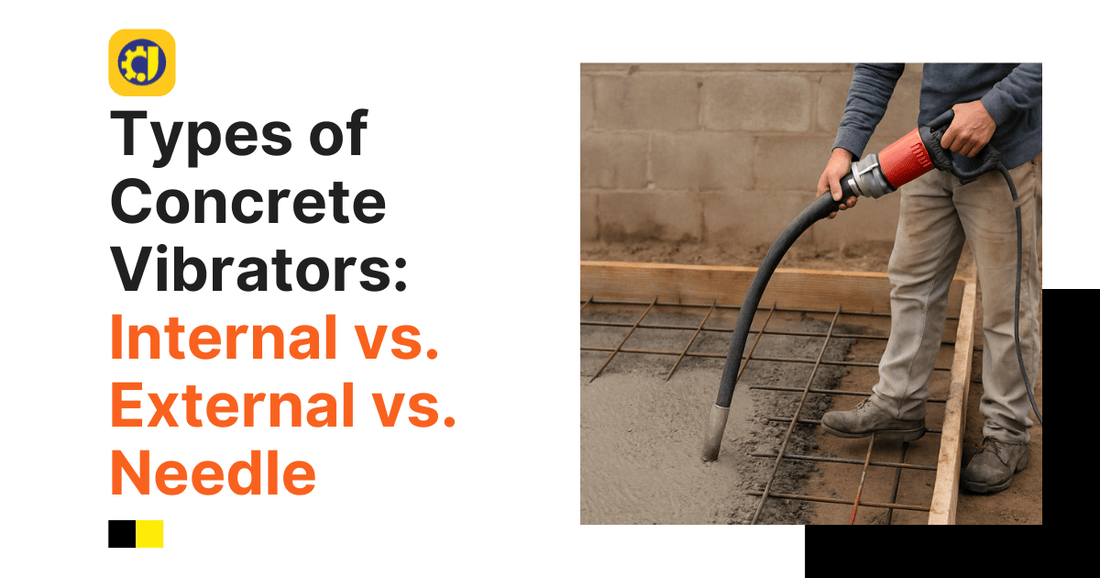
Types of Concrete Vibrators: Internal vs. External vs. Needle
Concrete work demands precision. One essential tool that ensures strong, durable, and well-compacted concrete is the concrete vibrator. Whether you're working on a small residential project or a massive commercial structure, using the right type of vibrator makes all the difference.
In this post, we’ll break down the three main types: internal, external, and needle concrete vibrators. Understanding their unique functions will help you choose the best option for your next project.
Why Use a Concrete Vibrator?
Before exploring the types, let’s understand why a concrete vibrator is so important.
Fresh concrete contains air pockets. If not removed, they weaken the structure and cause surface blemishes. A concrete vibrator removes trapped air, improving strength, finish, and longevity.
Moreover, it ensures that the mix spreads evenly into corners and around reinforcement bars. This is critical for stability and aesthetics.
Internal Concrete Vibrators
What Are Internal Vibrators?
Internal concrete vibrators, also called immersion vibrators, are the most common type. They consist of a vibrating head attached to a flexible shaft and motor. The head is inserted directly into the wet concrete.
When to Use Internal Vibrators
This type is ideal for deep pours, such as foundations, columns, and beams. It works best when the concrete is freshly poured and still fluid.
Key Benefits
Internal vibrators are efficient and easy to handle. They compact concrete from the inside out, which results in minimal air pockets and better bonding.
Additionally, they’re great for projects where precision and quality control matter most.
External Concrete Vibrators
What Are External Vibrators?
External concrete vibrators are attached to the outside of a formwork. Instead of inserting a tool into the concrete, they vibrate the entire mold or surface.
These are widely used in pre-cast concrete plants and surface-level applications.
When to Use External Vibrators
They’re perfect when internal vibration is not possible. For instance, in slim or complex molds where space is limited. External vibrators also help with finishes on decorative or exposed surfaces.
Key Benefits
Since they don’t touch the concrete directly, external vibrators are excellent for delicate work. They reduce the risk of leaving marks or voids near the surface.
Moreover, they can run continuously and are often mounted permanently in industrial settings.
Needle Concrete Vibrators
What Are Needle Vibrators?
Needle vibrators are a type of internal vibrator. However, the difference lies in their vibrating head, which is shaped like a long, thin needle.
They are known for their portability and ability to fit into narrow spaces.
When to Use Needle Vibrators
Needle vibrators are best used in areas with heavy rebar or where access is limited. For example, in tight columns, corners, or narrow beam structures.
They’re also ideal for small-scale jobs and repair work.
Key Benefits
Their slim design allows them to reach tricky spots. They’re also lightweight, making them easy to handle during extended use.
Importantly, they offer high-frequency vibration, which ensures quick and thorough compaction.
How to Choose the Right Type
Project Size and Scope
First, consider the size of your project. For large pours, internal vibrators or needle types are ideal. For pre-cast forms, go with external options.
Access and Complexity
If your formwork is complex or has limited access, a needle vibrator can reach where others can’t. On the other hand, external vibrators suit flat or detailed surfaces better.
Finish Quality
For exposed finishes or decorative concrete, external vibrators reduce blemishes. Internal vibrators may leave slight traces if not used carefully.
Conclusion
Choosing the right concrete vibrator is vital for a high-quality finish and structural integrity. Internal, external, and needle vibrators each have their strengths, depending on your needs.
Use internal vibrators for deep and large pours. Opt for external vibrators when dealing with delicate molds or pre-cast items. And rely on needle vibrators for narrow, hard-to-reach spaces.
In short, matching the tool to the job ensures better results, saves time, and avoids costly errors. So next time you pour concrete, pick the right type of vibrator and get the job done right.
Frequently Asked Questions
1. Can I use a concrete vibrator on all types of pours?
Not always. Some pours require specific types. For example, complex formworks need needle vibrators, while wide surfaces might benefit from external ones.
2. How long should I vibrate concrete?
Generally, 5–15 seconds per spot is enough. Over-vibration can cause segregation, while under-vibration may leave air pockets.
3. Is a needle vibrator different from an internal vibrator?
Technically, it’s a sub-type of internal vibrator. But it has a slimmer head to reach tighter spaces.